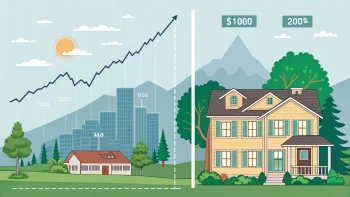People love the story. A relative bought a modest home decades ago and sold it for far more today. It sounds like a winning investment. As a portfolio manager and planner, I hear it often. The numbers tell a different story. When we strip out emotions and look at long-term results, stocks have delivered far more growth than a single home purchase. That does not mean housing is bad. It means we need to be clear about what builds wealth and what manages risk.
Table of Contents
ToggleThe Core Question: Which Has Done Better?
I walked through a simple example that mirrors the national experience. Think about a house bought for roughly $19,000 in 1963. Today, that same property would sell for about $514,000. That jump looks huge. But compound growth can be tricky. It works out to about 5.4% per year over six decades. Now layer in the real costs of ownership. Property taxes often run near 1% of the home’s value per year. Ongoing maintenance and big-ticket repairs can add another 2% per year over time. Net that out, and the annual return on the house falls near 2.4%.
Now compare that to the S&P 500. The broad U.S. stock market has averaged about 10.6% per year over the same stretch. The cost to own is tiny if you use an index fund. The fee can be around 0.03% per year. If you took that same $19,000 and put it in an S&P 500 index fund in 1963, today you would be looking at something near $9,960,000. This is why I emphasize stocks as the engine of long-term wealth.
“I own real estate because it’s a great diversifier, but let’s put this debate to bed. It’s clear that investment dollars have been far better served in stocks than in real estate.”
— Taylor Sohns, CEO of LifeGoal Wealth Advisors, CIMA, CFP
View this post on Instagram
Key Takeaways at a Glance
- Historic home price growth has averaged about 5.4% per year before costs.
- After taxes and maintenance, the net return on a home can drop near 2.4% per year.
- The S&P 500 has averaged about 10.6% per year over the same period.
- Owning the market through a low-cost index fund can cost about 0.03% per year.
- Real estate still plays a role as a diversifier and as shelter, but it is not the top growth driver.
Why The House Story Feels So Convincing
Real estate stories are personal. A home is a big part of family life. We make memories there, and the value often rises over time. That lived experience sticks. But personal stories, even when true, can hide the silent costs. The roof eventually leaks. The furnace fails. You repaint, replace flooring, and patch the driveway. Many owners do not track these expenses. When the sale check arrives, it feels like pure profit. It is not.
Taxes also sit in the background. Property tax never stops. Even if a mortgage is paid off, the bill keeps coming. Some states and counties tax heavily. Others tax lightly. Over decades, even 1% a year eats into returns. Insurance and closing costs add even more. None of that shows up in the sale price alone.
Then there is the time. Homeownership demands attention. You schedule contractors, meet inspectors, and spend weekends on upkeep. Time has value. While it is hard to put a price on your effort, it is part of the real cost of a home. Stocks do not ask for that level of personal labor.
Stocks: The Math of Compounding Works Harder
Stocks represent ownership in businesses. Those businesses grow profits, reinvest, and pay dividends. Over long periods, that growth compounds. Market declines happen. They can be frightening. But the trend over many decades has been up. That is because the economy grows, productivity rises, and innovation adds value.
Low-cost index funds make owning this growth cheap and straightforward. A fee of about 0.03% per year is a rounding error compared with other costs in life. Keep costs low and hold for the long run. That is the core of many successful portfolios. It is boring. It is also effective.
The Home Is Not Just an Investment
We should be clear about the purpose of a primary residence. A home is first about shelter and lifestyle. It is part of daily life. Kids walk to school. Commutes matter. You paint walls the color you want. The “return” from safety, control, and comfort is real. It is just not a financial return. Treating a primary home like a stock holding misses the point.
Investors also often overlook that a single home is a concentrated bet on one location. Neighborhoods change. Local jobs rise and fall. Weather risks mount. Stocks spread that risk across many sectors and regions. A broad index holds hundreds of companies. That diversification reduces the impact of any one problem.
What About Leverage, Rents, and Tax Breaks?
Leverage can change the math for real estate. A buyer can put 20% down, take a mortgage, and control a large asset. If the property grows, the return on your cash can look strong. That is real. But leverage cuts both ways. If prices fall or rents drop, the hit on your equity can be sharp. Debt magnifies outcomes.
Rental income also matters. A well-bought property can throw off cash flow after expenses. Smart owners budget for vacancies, repairs, property management, insurance, and taxes. Net operating income after these costs is what counts. Many investors underestimate these line items. Small misses add up.
The tax code helps housing owners in ways that can improve net returns. Mortgage interest may be deductible for some owners. Primary home gains can be excluded up to set limits if the owner meets the rules. Landlords can use depreciation to shield income, though that can be recaptured at sale. These are fundamental tools. Even with tax help, long-term stock returns have outpaced housing returns in most national averages.
Behavior Matters More Than Headlines
Behavior can make or break a plan. Some investors sell stocks after a drop and lock in losses. Others buy houses at peak prices out of fear of missing out. Good behavior is simple but not easy. Set a long-term plan. Keep a healthy cash buffer. Add money on a schedule. Avoid big bets on one asset or one story.
I prefer to keep housing and investing in their proper lanes. Use a home for living and stability. Use stocks and bonds for growth and income. When you mix those roles, you risk odd decisions. You might hold too much equity in one zip code. Or you might avoid repairs that protect value because you view the home as only an “asset.” A clean plan reduces these frictions.
How I Think About Building a Strong Portfolio
My framework is straightforward. Use low-cost stock funds as the main growth driver. Add bonds for stability if your timeline is shorter or your risk tolerance is lower. Consider real estate in measured doses. That can be a primary home bought with a long holding period in mind. It can also be real estate investment trusts (REITs) for diversification without direct property management.
Time horizon should guide the mix. If you have decades, lean more on stocks. If you need funds soon, limit risk and keep more in short-term bonds and cash. Rebalance on a set schedule. That forces you to sell some winners and add to laggards. It is a disciplined way to “buy low and sell high” without guessing.
Putting the Numbers in Context
Let us bring the numbers back together for clarity.
- A typical home’s price growth over 60 years: about 5.4% per year.
- Less 1% for property taxes and 2% for upkeep: net near 2.4% per year.
- S&P 500 average annual return over the same span: about 10.6% per year.
- Index fund cost: about 0.03% per year.
- $19,000 invested in the S&P 500 in 1963 is roughly $9.96 million today.
This is not cherry-picking. It reflects an extended period across different markets and cycles. Stocks had crashes and booms. Real estate had slumps and booms. Over the full ride, stocks did more heavy lifting for wealth building.
Risks That Deserve Respect
Stocks can drop hard and fast. A bear market can cut values by 30% or more. That risk is the reason the long-term return is high. You get paid to bear that volatility. Holding through storms is the work.
Real estate has its own risks. It can be illiquid. Selling a house takes time and money. Local shocks hit fast and deep. A plant closes. A flood map changes. Insurance costs climb. Being ready for these risks means maintaining cash reserves and avoiding overloading on a single property.
Practical Steps You Can Take
Start by writing down your goals and timelines. Match your asset mix to those goals. Automate investments each month into a low-cost stock fund and, if needed, a bond fund. If you plan to buy a home, think long term. Focus on a payment that fits your budget with room for repairs and savings. Do not bank on fast price gains.
Review once or twice a year. Rebalance to your targets. Increase your savings rate when your income rises. Keep your fees as low as possible. Resist hot tips, scary headlines, and social media hype. Steady beats flashy.
Why I Still Like Real Estate—In Its Place
I own real estate. It adds a different stream of returns to a portfolio. It can hedge against inflation. Rents and property values often rise with prices over time. It also moves differently from stocks at times, which helps smooth the ride. That is the value: diversification. It is not the top growth engine. That role belongs to stocks.
The cleanest approach is balance. Let stock funds power growth. Use bonds and cash for short-term needs. Use real estate in a role that fits your life and risk tolerance. That blend gives you stability, income, and growth without leaning too hard on any one bet.
The Bottom Line
Stories about a house that soared in price feel great. But the math favors stocks for building long-term wealth. Housing still matters for living well and can help diversify a plan. Use each tool for its best job. If you want growth, own the market at low cost and give it time. If you want stability and a place to live, buy a home you can afford and keep it in good shape. Put those pieces together, and your money works harder with less stress.

















